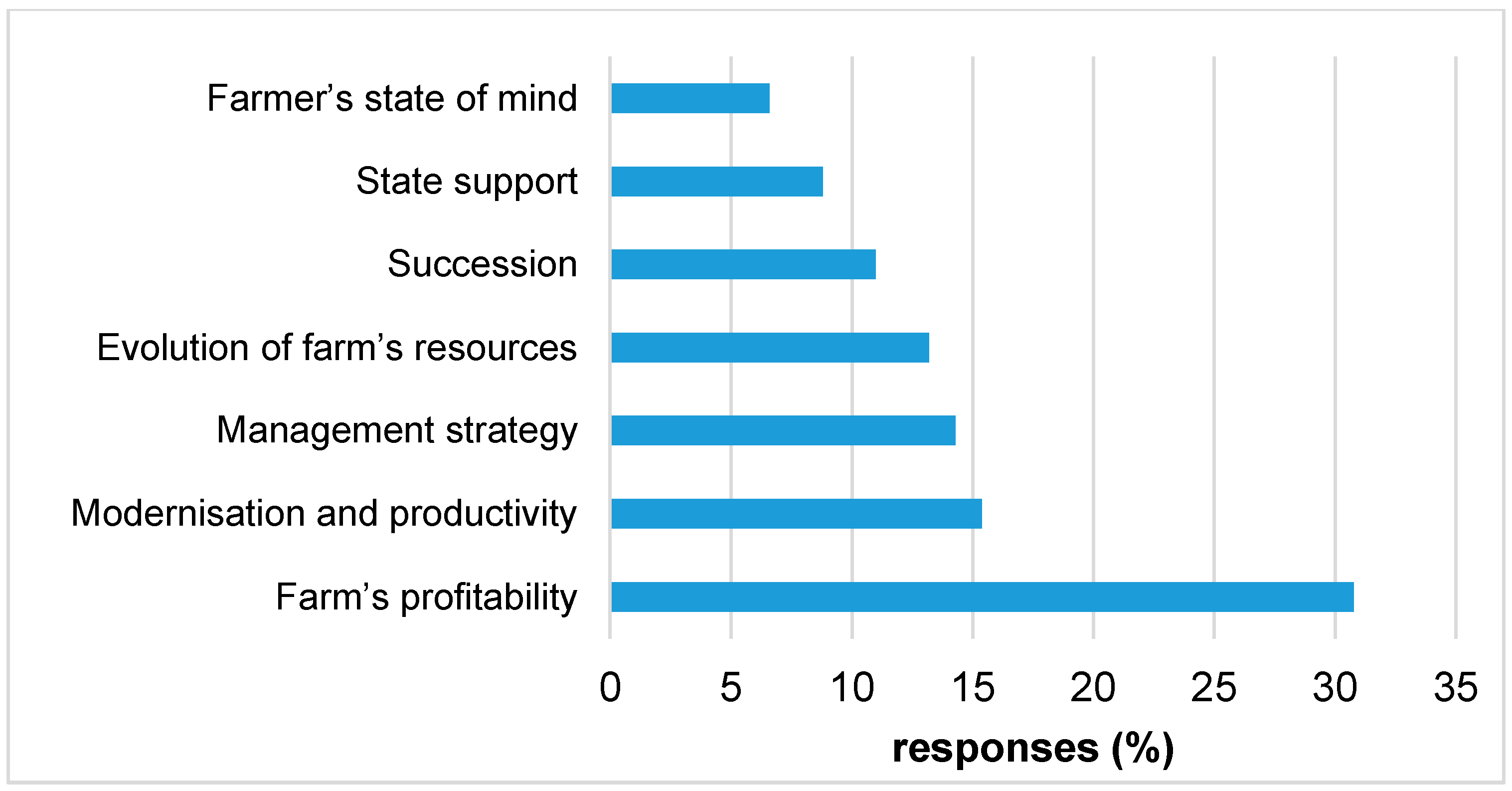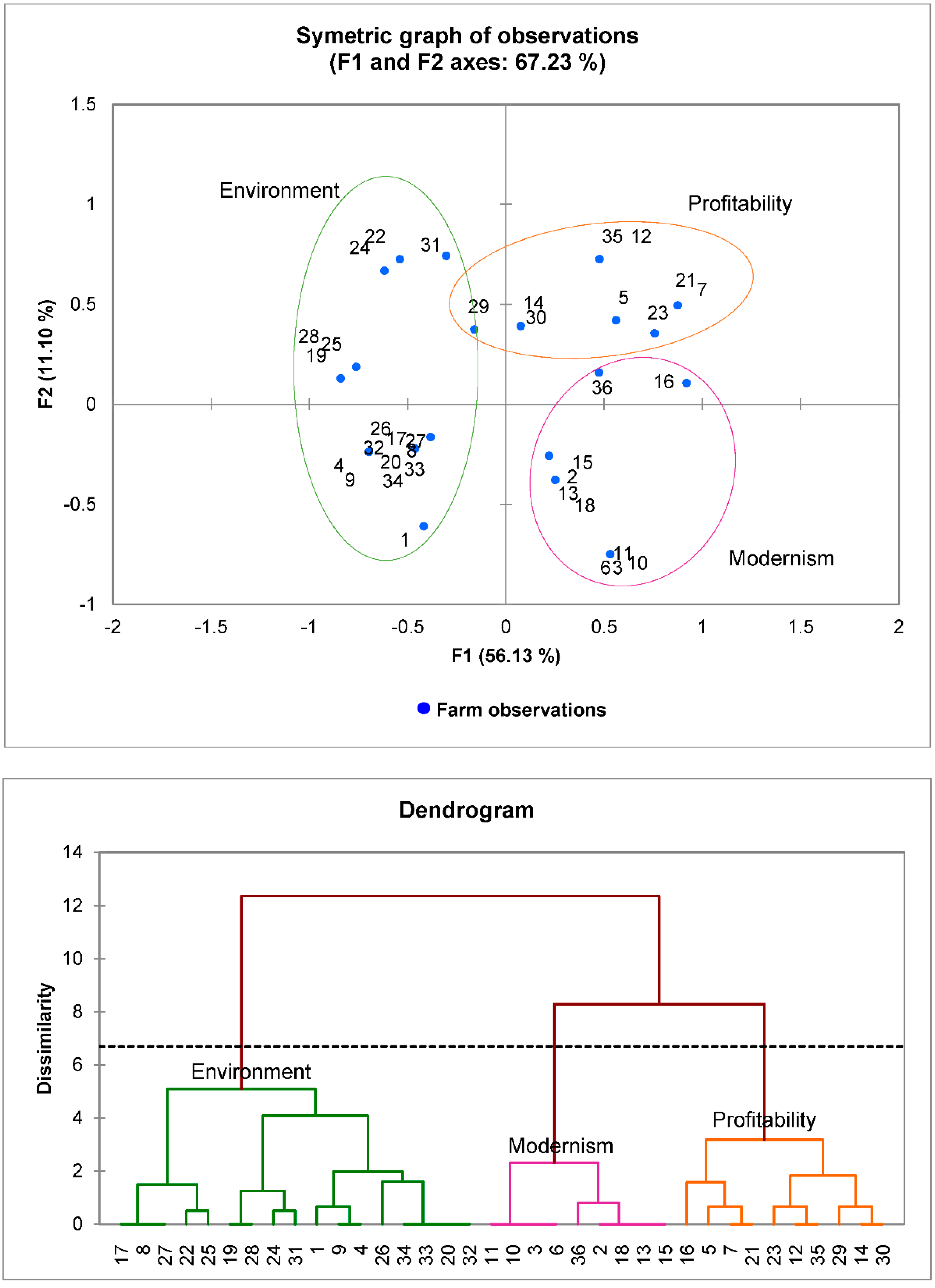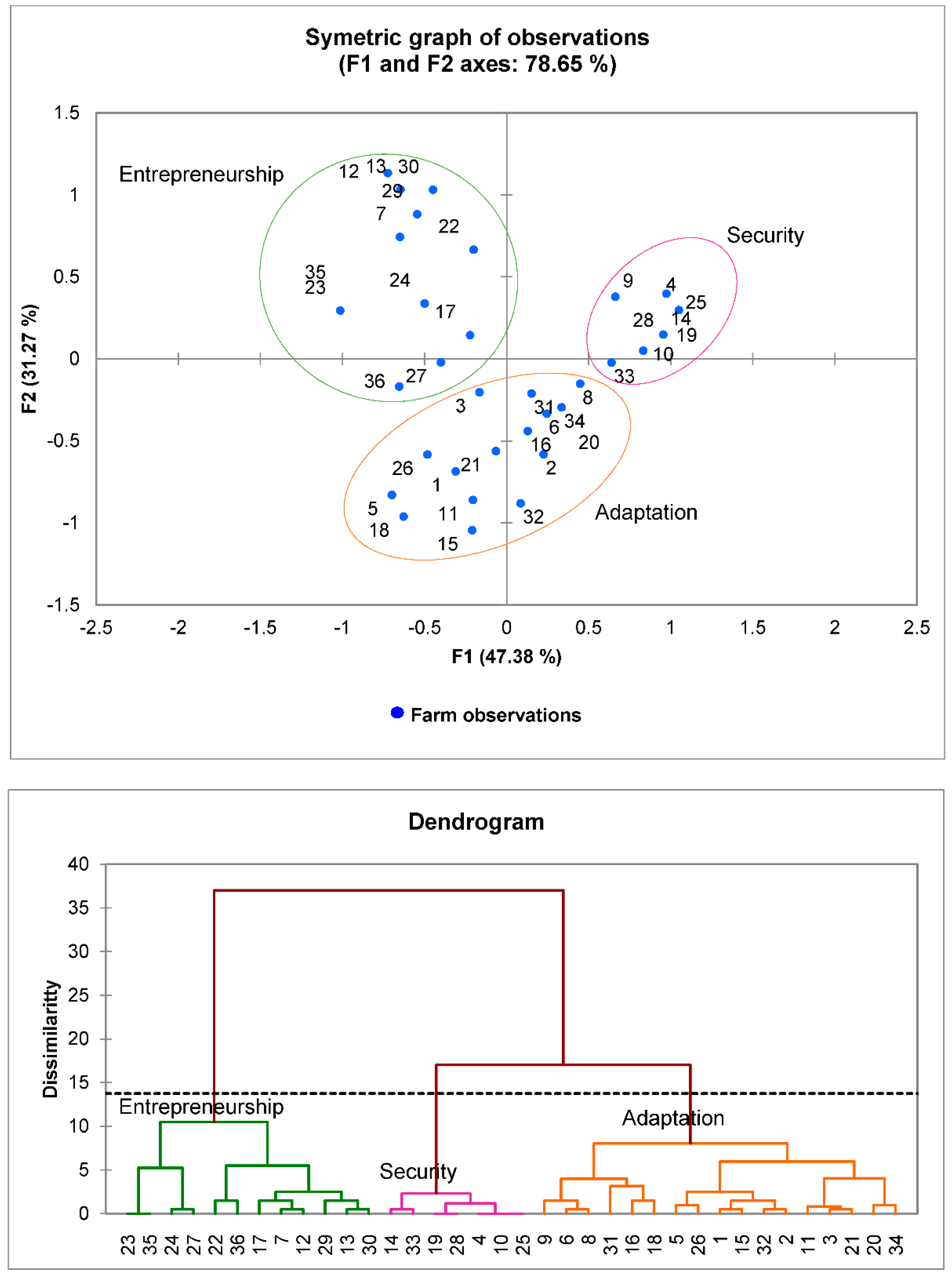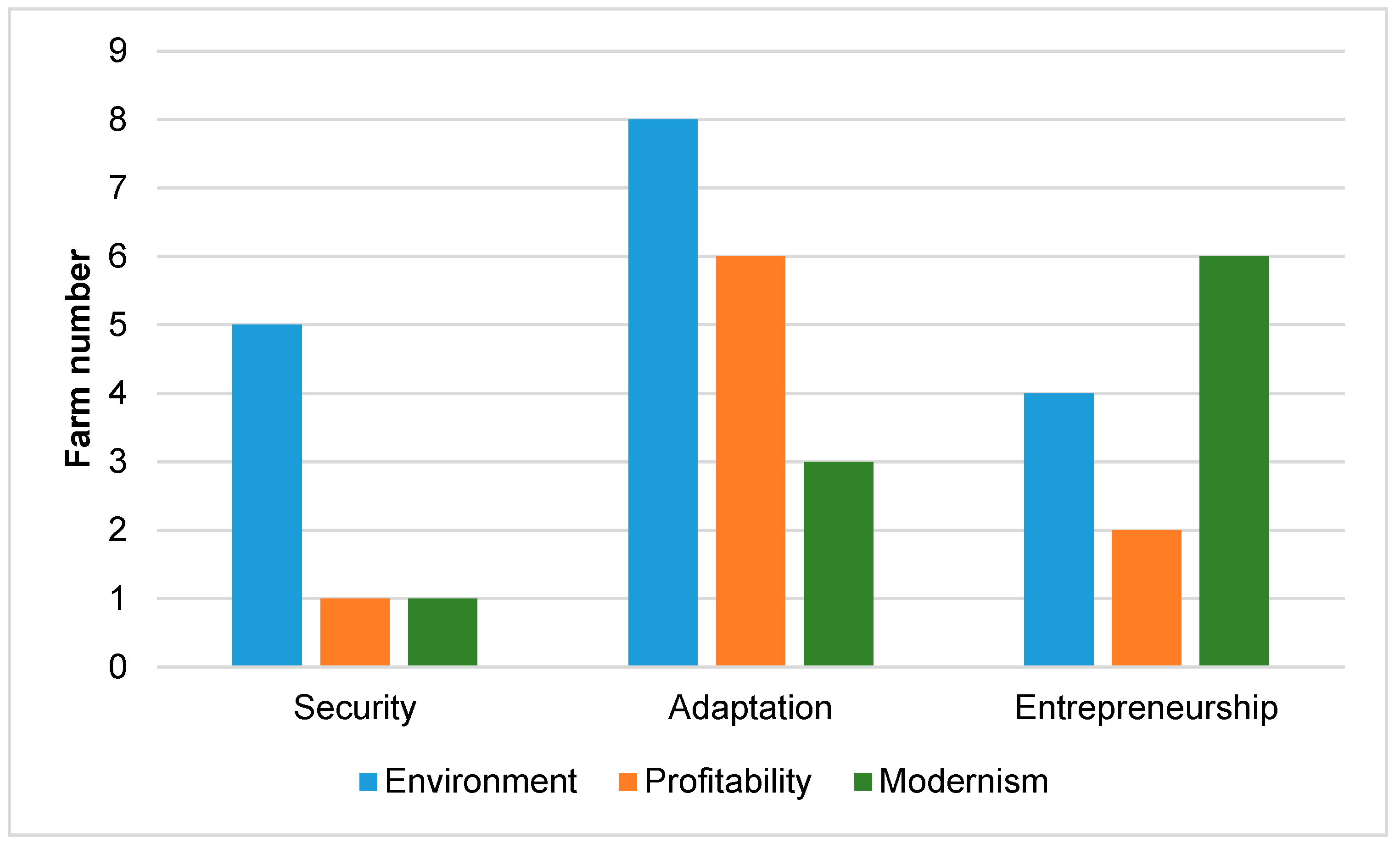Sustainability Viewed from Farmers’ Perspectives in a Resource-Constrained Environment
Abstract
1. Introduction
2. Materials and Methods
2.1. Study Context
2.2. Sampling and Data Collection
2.3. Data Analysis
3. Results
3.1. Farmers’ Perceptions of the Notion of Farm Sustainability
3.2. Three Types of Strategies to Endure
3.2.1. Income Security and Farm Autonomy through Low-Intensity Practices
3.2.2. Adaption and Valorization of the Farm’s Flexibility according to Opportunities
3.2.3. Entrepreneurial Strategy Seeking Productivity and Maximum Income
3.3. Linking Farmers’ Sustainability Perceptions with Their Strategies to Endure
4. Discussion
4.1. Farmers’ Perceptions and Strategies to Endure Viewed through the Concept of Sustainability
4.2. Public Instruments Linked to Sustainability and Changes in Farmers’ Practices
5. Conclusions
Author Contributions
Funding
Acknowledgments
Conflicts of Interest
References
- Lemaire, G.; Franzluebbers, A.; Carvalho, P.C.; Dedieu, B. Integrated crop–livestock systems: Strategies to achieve synergy between agricultural production and environmental quality. Agric. Ecosyst. Environ. 2014, 190, 4–8. [Google Scholar] [CrossRef]
- Evans, N. Adjustment strategies revisited: Agricultural change in the Welsh Marches. J. Rural Stud. 2009, 25, 217–230. [Google Scholar] [CrossRef]
- Swilling, M.; Musango, J.; Wakeford, J. Developmental States and Sustainability Transitions: Prospects of a Just Transition in South Africa. J. Environ. Policy Plan. 2016, 18, 650–672. [Google Scholar] [CrossRef]
- Schoon, B.; Te Grotenhuis, R. Values of farmers, sustainability and agricultural policy. J. Agric. Environ. Ethics 2000, 12, 17–27. [Google Scholar] [CrossRef]
- Schreinemachers, P.; Balasubramaniam, S.; Boopathi, N.M.; Ha, C.V.; Kenyon, L.; Praneetvatakul, S.; Sirijinda, A.; Tuan Le, N.; Srinivasan, R.; Wu, M.H. Farmers’ perceptions and management of plant viruses in vegetables and legumes in tropical and subtropical Asia. Crop Prot. 2015, 75, 115–123. [Google Scholar] [CrossRef]
- Fairweather, J.R.; Hunt, L.M. Can farmers map their farm system? Causal mapping and the sustainability of sheep/beef farms in New Zealand. Agric. Hum. Values 2011, 28, 55–66. [Google Scholar] [CrossRef]
- Lankester, A. Self-perceived Roles in Life and Achieving Sustainability on Family Farms in North-eastern Australia. Aust. Geogr. 2012, 43, 233–251. [Google Scholar] [CrossRef]
- Assefa, E.; Hans-Rudolf, B. Farmers’ Perception of Land Degradation and Traditional Knowledge in Southern Ethiopia-Resilience and Stability: farmers’ perception of land degradation and traditional knowledge. Land Degrad. Dev. 2016, 27, 1552–1561. [Google Scholar] [CrossRef]
- Kelemen, E.; Nguyen, G.; Gomiero, T.; Kovács, E.; Choisis, J.P.; Choisis, N.; Paoletti, M.G.; Podmaniczky, L.; Ryschawy, J.; Sarthou, J.P.; et al. Farmers’ perceptions of biodiversity: Lessons from a discourse-based deliberative valuation study. Land Use Policy 2013, 35, 318–328. [Google Scholar] [CrossRef]
- Bekkar, Y.; Kuper, M.; Errahj, M.; Faysse, N.; Gafsi, M. On the difficulty of managing an invisible resource: Farmers’ strategies and perceptions of groundwater use, field evidence from Morocco. Irrig. Drain. 2009, 58, S252–S263. [Google Scholar] [CrossRef]
- Fairweather, J.R.; Campbell, H.R. Environmental Beliefs and Farm Practices of New Zealand Farmers: Contrasting Pathways to Sustainability. Agric. Hum. Values 2003, 20, 287–300. [Google Scholar] [CrossRef]
- Füsun Tatlıdil, F.; Boz, İ.; Tatlidil, H. Farmers’ perception of sustainable agriculture and its determinants: A case study in Kahramanmaras province of Turkey. Environ. Dev. Sustain. 2009, 11, 1091–1106. [Google Scholar] [CrossRef]
- White, M.A. Sustainability: I know it when I see it. Ecol. Econ. 2013, 86, 213–217. [Google Scholar] [CrossRef]
- Bolis, I.; Morioka, S.N.; Sznelwar, L.I. When sustainable development risks losing its meaning. Delimiting the concept with a comprehensive literature review and a conceptual model. J. Clean. Prod. 2014, 83, 7–20. [Google Scholar] [CrossRef]
- Rueff, C.; Choisis, J.P.; Balent, G.; Gibon, A. A Preliminary Assessment of the Local Diversity of Family Farms Change Trajectories Since 1950 in a Pyrenees Mountains Area. J. Sustain. Agric. 2012, 36, 564–590. [Google Scholar] [CrossRef]
- Ryschawy, J.; Choisis, N.; Choisis, J.P.; Joannon, A.; Gibon, A. Mixed crop-livestock systems: An economic and environmental-friendly way of farming? Animal 2012, 6, 1722–1730. [Google Scholar] [CrossRef] [PubMed]
- Ryschawy, J.; Choisis, N.; Choisis, J.P.; Gibon, A. Paths to last in mixed crop–livestock farming: Lessons from an assessment of farm trajectories of change. Animal 2013, 7, 673–681. [Google Scholar] [CrossRef]
- Suess-Reyes, J.; Fuetsch, E. The future of family farming: A literature review on innovative, sustainable and succession-oriented strategies. J. Rural Stud. 2016, 47, 117–140. [Google Scholar] [CrossRef]
- Baccar, M.; Bouaziz, A.; Dugué, P.; Le Gal, P.Y. Shared environment, diversity of pathways: Dynamics of family farming in the Saïs Plain (Morocco). Reg. Environ. Chang. 2017, 17, 739–751. [Google Scholar] [CrossRef]
- Faysse, N.; EL Amrani, M.; EL Aydi, S.; Lahlou, A. Formulation and implementation of policies to deal with groundwater overuse in morocco: Which supporting coalitions? Policies to deal with groundwater overuse in morocco. Irrig. Drain. 2012, 61, 126–134. [Google Scholar] [CrossRef]
- Lejars, C.; Courilleau, S. Impact du développement de l’accès à l’eau souterraine sur la dynamique d’une filière irriguée. Le cas de l’oignon d’été dans le Saïs au Maroc. Cah. Agric. 2014, 24, 1–10. [Google Scholar] [CrossRef]
- Akesbi, N. Une nouvelle stratégie pour l’agriculture marocaine: Le Plan Maroc Vert. New Medit 2012, 11, 12–23. [Google Scholar]
- Tilman, D.; Cassman, K.G.; Matson, P.A.; Naylor, R.; Polasky, S. Agricultural sustainability and intensive production practices. Nature 2002, 418, 671–677. [Google Scholar] [CrossRef] [PubMed]
- Baccar, M.; Bouaziz, A.; Dugué, P.; Gafsi, M.; Le Gal, P.Y. The determining factors of farm sustainability in a context of growing agricultural intensification. Agroecol. Sustain. Food Syst. 2019, 43, 386–408. [Google Scholar] [CrossRef]
- Thompson, P.B. Agricultural sustainability: What it is and what it is not. Int. J. Agric. Sustain. 2007, 5, 5–16. [Google Scholar] [CrossRef]
- Chatterjee, S.; Goswami, R.; Bandyopadhyay, P. Methodology of identification and characterization of farming systems in irrigated agriculture: Case study in west Bengal State of India. J. Agric. Sci. Technol. 2015, 17, 1127–1140. [Google Scholar]
- Choisis, J.P.; Thévenet, C.; Gibon, A. Analyzing farming systems diversity: A case study in south-western France. Span. J. Agric. Res. 2012, 10, 605–618. [Google Scholar] [CrossRef]
- Ryschawy, J.; Choisis, N.; Choisis, J.P.; Joannon, A.; Gibon, A. Quelles stratégies pour un maintien de la polyculture-élevage ? Une étude des trajectoires passées d’exploitations dans les coteaux de Gascogne. In L’agriculture En Famille: Travailler, Réinventer, Transmettre; Gasselin, P., Choisis, J.P., Petit, S., Purseigle, F., Zasser, S., Eds.; EDP Sciences: Les Ulis, France, 2015; pp. 287–304. [Google Scholar]
- Elo, S.; Kyngäs, H. The qualitative content analysis process. J. Adv. Nurs. 2008, 62, 107–115. [Google Scholar] [CrossRef]
- Bijnen, E.J. Cluster Analysis: Survey and Evaluation Techniques; Tilberg University Press: Tilberg, The Netherlands, 1973; p. 112. [Google Scholar] [CrossRef]
- Shaukat, S.S.; Rao, T.A.; Khan, M.A. Impact of sample size on principal component analysis ordination of an environmental data set: Effects on eigenstructure. Ekológia (Bratislava) 2016, 35, 173–190. [Google Scholar] [CrossRef]
- Jung, S.; Lee, S. Exploratory factor analysis for small samples. Behav. Res. 2011, 43, 701–709. [Google Scholar] [CrossRef]
- Howard, R.J.; Tallontire, A.M.; Stringer, L.C.; Marchant, R.A. Which “fairness”, for whom, and why? An empirical analysis of plural notions of fairness in Fairtrade Carbon Projects, using Q methodology. Environ. Sci. Policy 2016, 56, 100–109. [Google Scholar] [CrossRef]
- Lincoln, N.K.; Ardoin, N.M. Cultivating values: Environmental values and sense of place as correlates of sustainable agricultural practices. Agric. Hum. Values 2016, 33, 389–401. [Google Scholar] [CrossRef]
- Shucksmith, M.; Herrmann, V. Future changes in British agriculture: Projecting divergent farm household behaviour. J. Agric. Econ. 2002, 53, 37–50. [Google Scholar] [CrossRef]
- Bond, A.; Morrison-Saunders, A.; Pope, J. Sustainability assessment: The state of the art. Impact Assess. Proj. Apprais. 2012, 30, 53–62. [Google Scholar] [CrossRef]
- Gafsi, M.; Legagneux, B.; Nguyen, G.; Robin, P. Towards sustainable farming systems: Effectiveness and deficiency of the French procedure of sustainable agriculture. Agric. Syst. 2006, 90, 226–242. [Google Scholar] [CrossRef]
- Carr, S.; Tait, J. Differences in the attitudes of farmers and conservationists and their implications. J. Environ. Manag. 1991, 32, 281–294. [Google Scholar] [CrossRef]
- Stock, P.V. “Good farmers” as reflexive producers: An examination of family organic farmers in the US Midwest. Sociol. Rural. 2007, 47, 83–102. [Google Scholar] [CrossRef]
- Ameur, F.; Lejars, C.; Dugué, P.; Kuper, M. Prosper, survive or exit: Contrasted fortunes of farmers in the groundwater economy in the Sais plain (Morocco). Agric. Water Manag. 2017, 191, 207–217. [Google Scholar] [CrossRef]
- Kuper, M.; Faysse, N.; Hammani, A.; Hartani, T.; Marlet, S.; Hamamouche, M.F.; Ameur, F. Liberation or Anarchy? The Janus Nature of Groundwater Use on North Africa’s New Irrigation Frontiers. In Integrated Groundwater Management; Jakeman, A.J., Barreteau, O., Randall, J., Hunt, R.J., Rinaudo, J.D., Ross, A., Eds.; Springer International Publishing: Cham, Switzerland, 2016; pp. 583–615. [Google Scholar] [CrossRef]
- Lejars, C.; Fusillier, J.L.; Bouarfa, S.; Coutant, C.; Brunel, L.; Rucheton, G. Limitation of agricultural groundwater uses in Beauce (France): What are the impacts on farms and on the food processing sector? Irrig. Drain. 2012, 61, 54–64. [Google Scholar] [CrossRef]
- Khan, M.; Mahmood, H.Z.; Damalas, C.A. Pesticide use and risk perceptions among farmers in the cotton belt of Punjab, Pakistan. Crop Prot. 2015, 67, 184–190. [Google Scholar] [CrossRef]
- Aubry, C.; Ramamonjisoa, J.; Dabat, M.H.; Rakotoarisoa, J.; Rakotondraibe, J.; Rabeharisoa, L. Urban agriculture and land use in cities: An approach with the multi-functionality and sustainability concepts in the case of Antananarivo (Madagascar). Land Use Policy 2012, 29, 429–439. [Google Scholar] [CrossRef]
- Ingram, J. Agronomist–farmer knowledge encounters: An analysis of knowledge exchange in the context of best management practices in England. Agric. Hum. Values 2008, 25, 405–418. [Google Scholar] [CrossRef]
- Cross, R.; Ampt, P. Exploring Agroecological Sustainability: Unearthing Innovators and Documenting a Community of Practice in Southeast Australia. Soc. Nat. Resour. 2017, 30, 585–600. [Google Scholar] [CrossRef]
- Diehl, J.A.; Bose, M.; Main, D.S. A Social and Spatial Network Approach to Understanding Beliefs and Behaviors of Farmers Facing Land Development in Delhi, India. In Cities as Spatial and Social Networks. Human Dynamics in Smart Cities; Ye, X., Liu, X., Eds.; Springer: Cham, Switzerland, 2019; pp. 73–99. [Google Scholar] [CrossRef]
- Sereke, F.; Dobricki, M.; Wilkes, J.; Kaeser, A.; Graves, A.R.; Szerencsits, E.; Herzog, F. Swiss farmers don’t adopt agroforestry because they fear for their reputation. Agrofor. Syst. 2016, 90, 385–394. [Google Scholar] [CrossRef]
- Guichard, L.; Dedieu, F.; Jeuffroy, M.H.; Meynard, J.M.; Reau, R.; Savini, I. Le plan Ecophyto de réduction d’usage des pesticides en France: Décryptage d’un échec et raisons d’espérer. Cah. Agric. 2017, 26, 1–12. [Google Scholar] [CrossRef]
- Wunder, S. Revisiting the concept of payments for environmental services. Ecol. Econ. 2015, 117, 234–243. [Google Scholar] [CrossRef]
- Sanglestsawai, S.; Rejesus, R.M.; Yorobe, J.M. Economic impacts of integrated pest management (IPM) farmer field schools (FFS): Evidence from onion farmers in the Philippines. Agric. Econ. 2015, 46, 149–162. [Google Scholar] [CrossRef]
- Zhang, Q.; Xiao, H.; Duan, M.; Zhang, X.; Yu, Z. Farmers’ attitudes towards the introduction of agri-environmental measures in agricultural infrastructure projects in China: Evidence from Beijing and Changsha. Land Use Policy 2015, 49, 92–103. [Google Scholar] [CrossRef]
- Comer, S.; Ekanem, E.; Muhammad, S.; Singh, S.P.; Tegegne, F. Sustainable and Conventional Farmers: A Comparison of Socio-Economic Characteristics, Attitude, and Beliefs. J. Sustain. Agric. 1999, 15, 29–45. [Google Scholar] [CrossRef]
- Reardon, T.; Barrett, C.B.; Berdegué, J.A.; Swinnen, J.F.M. Agrifood Industry Transformation and Small Farmers in Developing Countries. World Dev. 2009, 37, 1717–1727. [Google Scholar] [CrossRef]




| Type | Rainfed | Diversified | Specialized | ||||
|---|---|---|---|---|---|---|---|
| T1a Small | T1b Large | T2a Veg a | T2b Fruit | T3a Veg | T3b Fruit | T3c Dairy | |
| Number of farms | 4 | 4 | 10 | 3 | 4 | 9 | 2 |
| Total area (ha) | 7 | 98 | 10 | 13 | 19 | 19 | 32 |
| Family MWU b | 2.3 | 2.8 | 1.9 | 2.2 | 2.5 | 1.7 | 1.8 |
| % cultivated area Rainfed crops | 100 | 98 | 67 | 30 | 35 | 31 | 86 |
| Irrigated vegetables | 0 | 0 | 26 | 44 | 58 | 6 | 0 |
| Irrigated fruit trees | 0 | 0 | 2 | 24 | 3 | 62 | 0 |
| Number of farms owning livestock Cattle | 3 | 2 | 8 | 2 | 3 | 4 | 2 |
| Sheep | 2 | 3 | 5 | 0 | 2 | 0 | 0 |
| Capital/MWU (*1000 MAD) | 213 | 953 | 565 | 539 | 614 | 1127 | 298 |
| Components | Measurement Variables | Type of Variable |
|---|---|---|
| Family characteristics | Family MWU a (% of total MWU) | Quantitative |
| Land tenure | Increasing cultivated surface through indirect tenure | Qualitative |
| Economic characteristics | SMIG b/MWU | Quantitative |
| Capital/MWU | Quantitative | |
| Choice and combination of production activities | Number of productions | Quantitative |
| Production management practices | Improvement of irrigation water supply | Qualitative |
| Area fertilized with manure (% of the UAA c) | Quantitative | |
| Pesticide management | Qualitative |
| Security | Adaptation | Entrepreneurship | |
|---|---|---|---|
| Number of farms | 7 | 17 | 12 |
| Family MWU a (% of total MWU) | 90 | 59 | 39 |
| Two generations present | 2 | 9 | 9 |
| Presence of livestock | 7 | 13 | 7 |
| UAA b (ha) | 7 | 19 | 41 |
| % rainfed crops | 90 | 58 | 48 |
| % irrigated market vegetables | 10 | 35 | 7 |
| % irrigated arboriculture | - | 6 | 41 |
| % organically fertilized | 35 | 15 | 38 |
| Polluting pressure c | 2.7 | 4.5 | 4.3 |
| Improvement of water availability | - | 8 | 8 |
| Recourse to private advisors | - | 2 | 9 |
| Recourse to subsidies | - | 9 | 7 |
| Income (SMIG d/MWU) | 1.4 | 3.8 | 12.7 |
| Capital/MWU (1000 *MAD) | 292 | 560 | 1103 |
Publisher’s Note: MDPI stays neutral with regard to jurisdictional claims in published maps and institutional affiliations. |
© 2020 by the authors. Licensee MDPI, Basel, Switzerland. This article is an open access article distributed under the terms and conditions of the Creative Commons Attribution (CC BY) license (http://creativecommons.org/licenses/by/4.0/).
Share and Cite
Baccar, M.; Bouaziz, A.; Dugué, P.; Gafsi, M.; Le Gal, P.-Y. Sustainability Viewed from Farmers’ Perspectives in a Resource-Constrained Environment. Sustainability 2020, 12, 8671. https://doi.org/10.3390/su12208671
Baccar M, Bouaziz A, Dugué P, Gafsi M, Le Gal P-Y. Sustainability Viewed from Farmers’ Perspectives in a Resource-Constrained Environment. Sustainability. 2020; 12(20):8671. https://doi.org/10.3390/su12208671
Chicago/Turabian StyleBaccar, Mariem, Ahmed Bouaziz, Patrick Dugué, Mohamed Gafsi, and Pierre-Yves Le Gal. 2020. "Sustainability Viewed from Farmers’ Perspectives in a Resource-Constrained Environment" Sustainability 12, no. 20: 8671. https://doi.org/10.3390/su12208671
APA StyleBaccar, M., Bouaziz, A., Dugué, P., Gafsi, M., & Le Gal, P.-Y. (2020). Sustainability Viewed from Farmers’ Perspectives in a Resource-Constrained Environment. Sustainability, 12(20), 8671. https://doi.org/10.3390/su12208671




